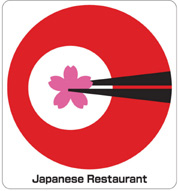 In what is good news for California Roll eaters, today Japan has formally announced a campaign for certifying Japanese food overseas without Big Brother inspecting the sushi. Initially covered back in December of 2006 in my piece “The sushi police are here to see you,” the Japanese ministry of Agriculture, along with a “non-governmental group of experts” has launched a campaign which will allow Japanese restaurants in various countries to certify their food as authentic and proudly display the Japanese Seal of Approval. With chopsticks holding a cherry blossom in front of a rising sun, the logo seems to capture the essence of Japanese food and culture, while allowing restaurants to tout their traditional offerings.
In what is good news for California Roll eaters, today Japan has formally announced a campaign for certifying Japanese food overseas without Big Brother inspecting the sushi. Initially covered back in December of 2006 in my piece “The sushi police are here to see you,” the Japanese ministry of Agriculture, along with a “non-governmental group of experts” has launched a campaign which will allow Japanese restaurants in various countries to certify their food as authentic and proudly display the Japanese Seal of Approval. With chopsticks holding a cherry blossom in front of a rising sun, the logo seems to capture the essence of Japanese food and culture, while allowing restaurants to tout their traditional offerings.
There will be no sushi police, merely the ability for restaurant goers to be sure that the food they are eating adheres to traditional standards. These standards do not cover foods such as the American California Roll and other items that westerners have become accustomed to, but may never have known are not standard fare in Japan. “Our objective is to promote Japanese food, not eliminate Japanese restaurants” a member of the board was quoted as saying.
In order to qualify for certification, restaurants should use authentic Japanese products, such as wasabi (preferably from the Izu peninsula), koshihikari rice (grown in Japan), pickled ginger (preferably from Tochigi), and miso paste (preferably from the Nagano mountains). They must also display knowledge of Japanese recipes as well as proper hygiene (great news! 🙂 ). Restaurants must adhere to the five specified criteria of authenticity, such as dish arrangement, originality, and customer service.
On March 27th and 28th the organization will be holding a conference to review the certification criteria and process, and have invited restaurant owners from around the world. There are an estimated 25,000 Japanese restaurants around to world, and that number is expected to double over the next few years. With all those restaurants, the hope is that as consumption of Japanese food increases world-wide, standards will be maintained, to a degree, and that Japanese food will remain relatively the same, unlike “Chinese food” restaurants, which have almost nothing in common with traditional Chinese meals. For westerners, you will still have your spicy tuna rolls,
MeshiAgare!
Warren
The sushi guy
I have always been fascinated by the creation and culture of different foods, particularly sushi and sashimi in the modern era of Japanese cuisine. I am a classically trained chef and sushi connoisseur, also having operated a food service company and enjoy investigating and experimenting with food around the world.
